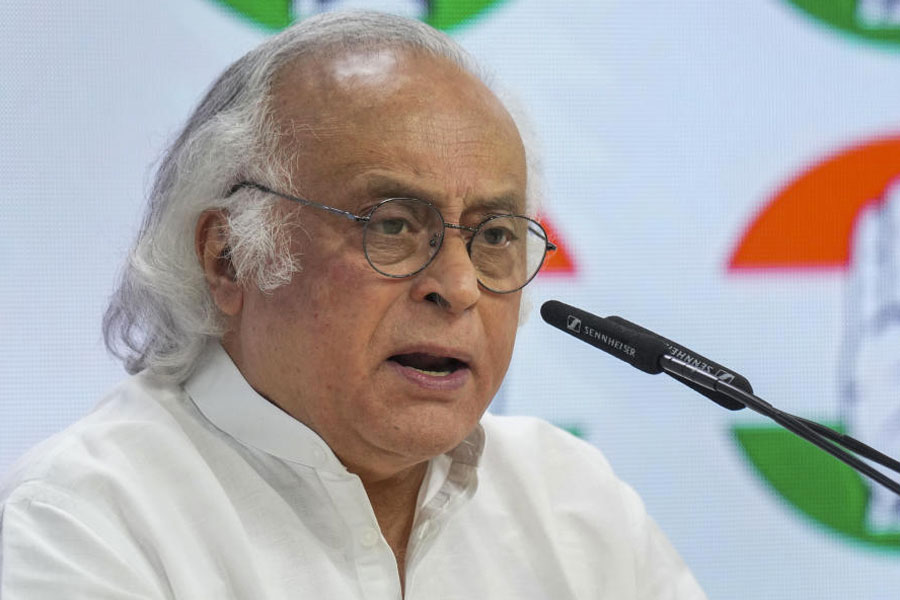 |
| The 159-year-old Howrah Station as seen from across the river. A file picture |
The 159-year-old red brick facade easily catches one’s eye travelling across the river to the west bank. Howrah Station, the gateway to eastern India, stands in resplendent glory, swathed in pale sunshine that highlights the grandeur of its colonial architecture. But as one approaches the heritage structure, a scene of complete chaos and mayhem breaks the illusion. Hundreds of passengers try hard to dodge the numerous hawkers, vendors, brokers, cabs, stalls and a hundred other obstacles that lie in their path as they hurry to catch their trains.
There are hawkers near the entry gates of the station trying to sell anything from fruits to locks and chains, a horde of brokers descend on the travel-weary passengers haggling with them over cab fares. Makeshift stalls occupy the sidewalks meant for passengers doing brisk business selling tea and snacks. All this, however, is gradually being done away with as Howrah city police have taken a string of measures to ensure both security and beautification outside the Howrah Station.
 |  |
| Hawkers line the main entrance to the station. (Right) Post-eviction, the entrance is free. Pictures by Gopal Senapati | |
“Actually we were getting worried by the growing security threat in and around the Howrah station area. The area was so crowded that any terrorist group could strike any moment and melt into the crowd. So we decided to remove hawkers from outside the station and take several security measures that included installing of CCTVs,” said Nishat Pervez, deputy commissioner of police (headquarter), Howrah.
This time round, removal of hawkers did not create any furore. While earlier during the Left Front regime, the dominant hawkers’ union was led by a ruling party leader from north Howrah, who stopped every move to evict hawkers exercising his influence in the party and in the administration. After the change of power in the 2011 Assembly elections, a leader from Trinamul Congress also from north Howrah started controlling the hawkers’ union. But he dared not protest the eviction as the decision of removing hawkers came from the top. “Before 2011, the hawkers’ union was controlled by an influential CPM leader from north Howrah. The union was so powerful that it was not possible for us to even stop new hawkers from adding to the confusion near the station gates, let alone driving them away. But now the situation is different. The present ruling party leader from north Howrah does not have the guts to go against his government’s decision to clear hawkers from the station area,” said a senior officer of Howrah city police. He said that though police were aware of the security threat they dared not raise their voice against the then ruling party leader in the past.
-37.jpg) |  |
| Fruits, clothes being sold by hawkers. Pictures by Gopal Senapati | After eviction, the road in front of the entrance to the station is cleared |
This time, the hawkers were not only evicted from near the gates of the Howrah station but also from near the bus stands near the Hooghly. “We no longer allow buses from Calcutta to park near the Howrah station. They have been asked to stop the buses only to allow the passengers to disembark,” said the deputy commissioner (traffic) Dipankar Bhattacharjee. Earlier, mini buses of several routes, including Kasba-Rathtala-Howrah, Kasba-Howrah, Golf Green-Howrah, Gariahat-Howrah were allowed to park near the Howrah station.
Rice hotels, tea stalls mushroomed near the bus stand. In the afternoon, vegetable vendors occupied most of the road leading to the Howrah station. “Even country-made liquor was sold near the taxi stand and bookies would operate openly in connivance with a section of the police outside the Howrah station. Those days are in the past now. Our government will not allow any antisocial activities near the station,” said Ashok Ghosh, MLA from north Howrah.
-40.jpg) | -41.jpg) |
| The Howrah bus stand near the station before eviction | The Calcutta bus stand is cleared after eviction |
After the hawkers were evicted, the road near the Hooghly was widened and renovated. Earlier, taxis were parked, near the police kiosk near the Howrah station, and brokers would openly whisk passengers into the waiting taxis and charge them double despite the existence of pre-paid taxi booth. “The officers on duty near the Howrah station have been asked categorically not to allow taxis to park near the kiosk and allow brokers near the taxi stand. Stern action will be taken on dereliction of duty,” said Pervez.
As a further step, at least 12 close circuit TVs will be installed bringing the entire area outside the Howrah station under the surveillance of police.“So far we have installed eight CCTV cameras both outside the old and new complex of the station. Four more will be installed soon,” said a senior police officer. Beside, removing hawkers from the bus stands, Howrah police decided to bring both the Howrah and the Calcutta bus stands under the surveillance of camera. Senior police claimed that police personnel would keep an eye on the monitors 24x7.
 |  |
| Pedestrians have a free passage after eviction | Before the drive, passengers had to negotiate through this congestion created by hawkers |
Howrah city police have modernised the prepaid taxi stand to stop the flood of complaints regarding booking prepaid taxis. Earlier, taxi drivers managed to get long-distance passengers by bribing the people manning the prepaid taxi stand. Recently, a device called Radio Frequency Identification Device (RFID) has been installed on the rear-view-mirror of every taxi. Whenever any taxi enters the booth, a recorder installed near the booth records the registration number of the taxi and allots a serial number to it so that no taxi can jump the queue or manipulate the system of allotment.
“A gang was active near the prepaid taxi booth. They did not allow the people at the booth to work properly. The new system will render them useless. The gang members were also a security threat to us,” said an officer of government railway police (GRP). He said that there were several gangs operating in the pre-paid taxi stand. They sometimes fought among themselves over the booty.
Howrah police has also talked to Calcutta Metropolitan Development Authority (CMDA) for the beautification of the area around Howrah station, including Sarat Park and Netaji Park. Sarat Park is near the approach road to the Bankim Setu and Netaji Park is near the approach road to the Howrah Bridge.
Both the parks are now in a very pitiable state. In the absence of maintenance, both parks have been covered with shrubs and creepers. Beggars and vagabonds stay there all over the year and at night the parks turn into dens of drug peddlers and their customers.
“We have requested CMDA to beautify the roads and the parks fall within the station area. Hope they will consider our request,” said Nishat Pervez, deputy commissioner (headquarter), Howrah.
 |  |
| The subway near the Calcutta bus stand is cleared giving free way to commuters | Before eviction, hawkers lined the entrance to the subway making entry and exit cumbersome |
The passengers are happy that the station area has been made clutter-free. “It is unbelievable. I never thought hawkers could be evicted from the Howrah station because they always enjoy political patronage. Now we can walk without any tension,” said Binay Krishan Dey, 45, a resident of Rishra.
Now the Howrah city police are waiting for orders from the Calcutta Port Trust (CPT) to pull down the makeshift hotels from the banks of the Hooghly. There are at least 30 hotels and restaurants lining the riverbank that have been closed for the last four years by a court order. These hotels and restaurants are blocking the view of the Hooghly.
'People coming from outside the state do not know that a beautiful river flows by so near the station. If the bank of the river is cleared of the hotels and restaurants, the Howrah station will look more beautiful,' said environmentalist Subhas Dutta. The police are now ready to pull down these structures.











